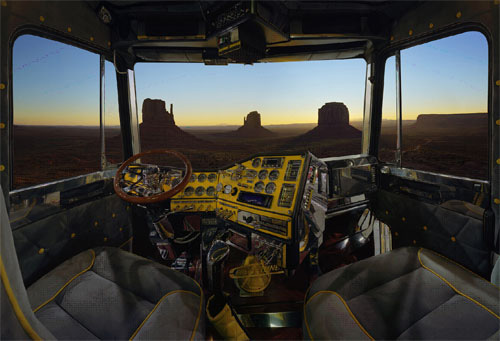
- Source: Los Angeles Times
- Author: Leah Ollman
- Date: June 26, 2009
- Format: PRINT AND DIGITAL
Luis Gispert
Exhibition Review
The interior environments in Luis Gispert’s photographs and film at Otero Plassart are carefully calibrated to satisfy: a truck cab outfitted like a gleaming, high-tech cockpit; a pre-adolescent boy’s playroom dimly lighted and project-filled as a man cave. But Gispert’s world is not decorous. The huge color photographs and even more so the 26-minute film titled “Smother” turn slick habitats into staging grounds for visceral threats and a variety of physical and psychic violations.
In each of the deftly manipulated photographs, Gispert perches us more or less in the driver’s seat of a powerful vehicle (semi, fighter plane), facing a landscape or cityscape glazed in romantic sunset hues. The disparate seductions of latent force and precious beauty clash, but the dissonance cancels itself out under the weight of the Brooklyn-based artist’s ultra-smooth technique. “Smother” too reads as convincing and disturbing but mostly as well crafted.

"Oh, Lorry Lorry." Credit: Luis Gispert
The film follows a day in the life of an androgynous, bed-wetting boy whose mother is alternately coddling and threatening. It starts with a bad dream and ends with strange and horrific violence. In between play out dramas of vulnerability, innocence and power, sexual predation, the encouragement of Oedipal urges, and spins on Freud’s castration complex.
The work is dense with trespassed boundaries, spilled bodily fluids and misplaced comfort. Though its production values are relatively high, its tone is purposefully muddled, making “Smother,” in the end, more superficially creepy than deeply resonant.

